Unexplored Japan: Adventures in the Heart of the Country
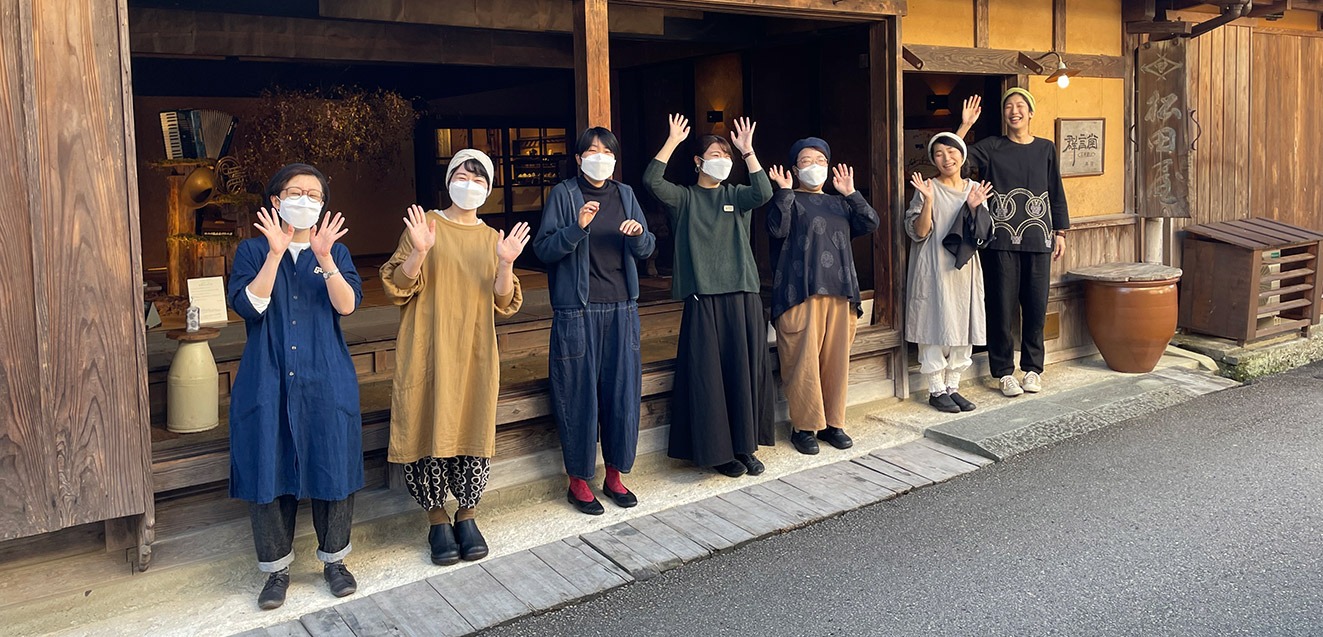
I have finished four exhilarating weeks traveling along the Japan Sea Coast in western Honshu, Japan’s main island, on GeoEx‘s Unexplored Japan journey. It has been tremendously exciting to be reminded of all the wonders, large and small, that led me to fall in love with this country and culture four decades ago.
There have been so many heart-soaring highlights on these two trips that it is almost impossible to choose just a few, but for this column I’d like to spotlight three of the most memorable meetings of my four weeks.
All three showcase some of the special thematic threads that have woven through our explorations and encounters: opening unfamiliar doors with a spirit of wonder, respect, attentiveness, and appreciation; connecting with fellow humans from vastly different backgrounds; sustaining and spreading cherished cultural traditions; celebrating culinary legacies and innovations; and conjuring intimate authentic adventures through congenial local contacts.
Yakitori Wonderland in Nagato:
On the second day of our journey, when we had already traveled by train and bus deep into the heart of the country, we stopped for lunch at a hole-in-the-wall yakitori eatery named Koumori in the town of Nagato. Happily, we were joined for lunch by Otani-san, the very gracious owner of the exquisite ryokan inn where we were staying, Bettei Otozure.
It was Otani-san who had originally recommended Koumori to us, and as we walked towards the shop, he told us that he had been going there since he was 14. When we reached the restaurant’s nondescript entrance, we slid past a huge red paper lantern, opened opaque sliding doors, and tumbled inside like Alice in Wonderland: Before us was a closet-sized, smoke-scented world, ten stools lining a neat counter, and beyond that an open area barely wide enough for two people to squeeze by, which contained a space for cleaning and preparing food and a brazier for grilling the restaurant’s skewered specialties. There were hand-written signs on the walls, and a bewildering variety of bottles on two shelves, and on first impression, that was all.
As Otani-san led us into the shop, the owner greeted us like old friends and warmly bade us sit. Our group—eight travelers, two guides, and Otani-san—filled all the stools, and magically, the shop became our enchanted little world for the next hour. Otani-san introduced Masakazu-san, the owner, and his wife, Keiko-san, and they set to work. Keiko-san deftly grilled skewers of one delicacy after another—cubes of chicken, freshly picked green peppers, straight-from-the-field-next-door mushrooms, locally made tofu, and more—right before our eyes, then plopped them still steaming on little plates in front of us. As she did so, Masakazu-san served beers and juices, and energetically explained that his grandmother had started the intimate eatery, and that he had taken over ownership from his mother, and that he loved serving delicious food to people and watching them enjoy it.
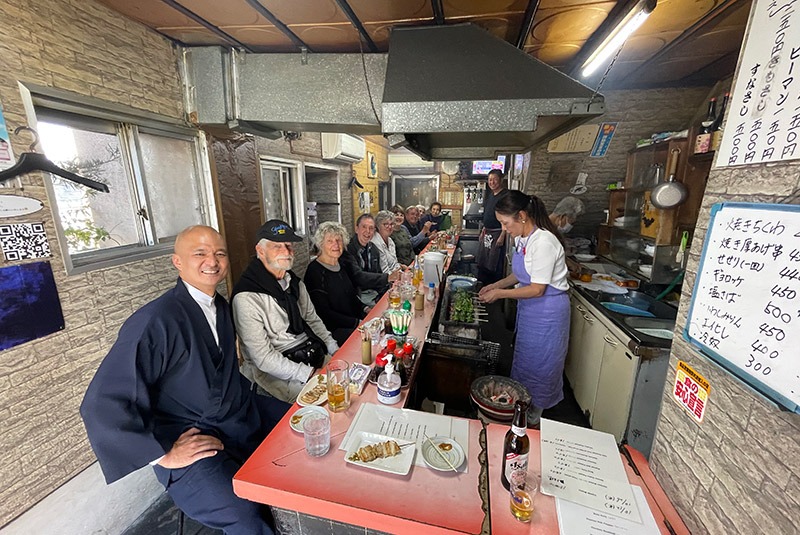
We enthusiastically shared our enjoyment, exclaiming with oohs and aahs and “Oishii!” (Japanese for “delicious”) as each course was served. The freshness of the food—the texture, smell, and taste of it hot off the grill—was a palate-epiphany, and the afternoon was made even more epiphanic by our ensuing conversation. As Keiko-san fanned and grilled and we happily gobbled down each delicious offering, Masakazu-san animatedly poured drinks and talked about everyday life in rural Japan: the joys of country peace, quiet, and natural beauty, and the challenges of sustaining a business with fewer and fewer diners.
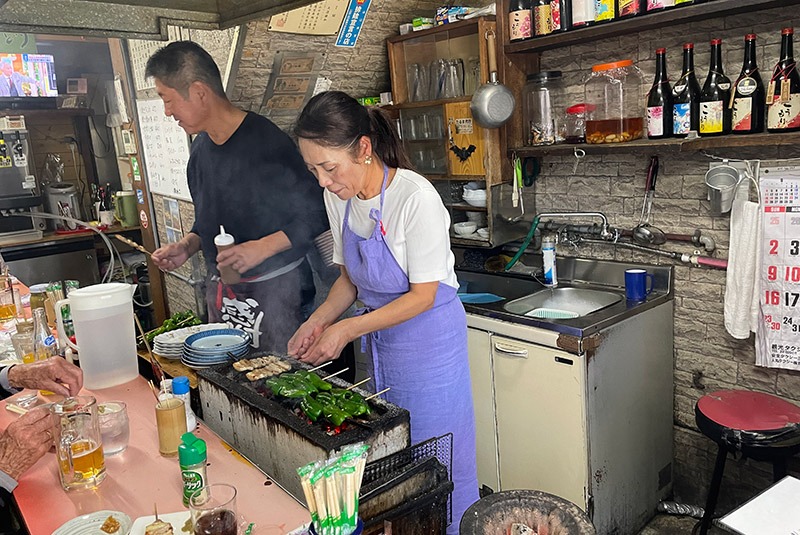
At one point he paused and looked at us all, and then with a big smile, announced that we were the first group of foreigners to visit his eatery. “I was so nervous!,” he said, laughing. We immediately toasted him and our visit with more beers. And he decided to join us. After a few more toasts, he told us that he liked to sing karaoke in his off time, and before we knew it, he was launching into a spirited rendition of “Stand by me!” Keiko-san laughed and said, “There goes the afternoon!”
As we were nearing the end of our delicious, laugh-filled feast, the owner suddenly announced, “I have a present for everyone!” He disappeared momentarily, then remerged holding aloft a precious bottle of a prize-winning local gin. Suddenly a dozen glasses materialized and he was pouring and telling us that this gin was produced locally using only organic herbs from the surrounding fields and that he saved it only for his truly special guests. Raising a glass, he exclaimed, “This is my gift to you, my new American friends,” and we all clinked our glasses and downed our drinks. Tears filled his eyes, and many of our eyes, too.
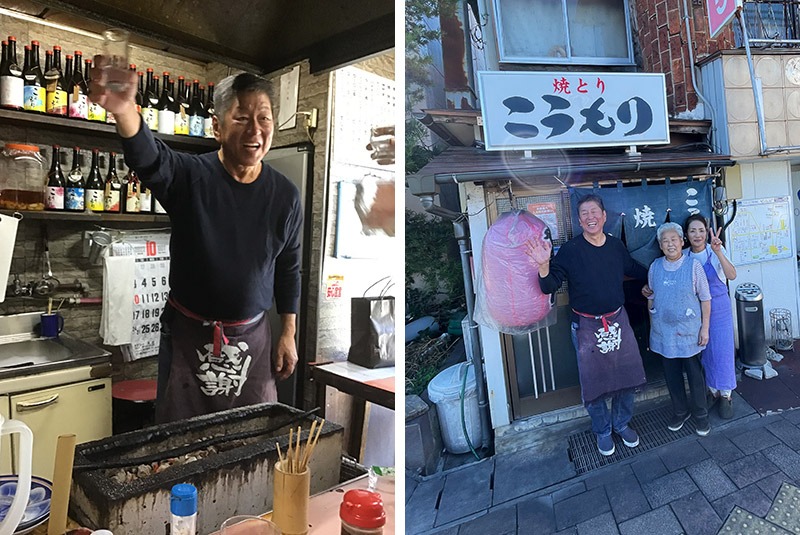
Restorations in Omori:
A second highlight was our stay in Omori, a peaceful one-street village of 400 spirited souls whose wooden homes and patchwork garden plots seemed frozen in the 18th century, when the nearby Iwami Ginzan silver mine had been one of the world’s most important silver-producing centers.
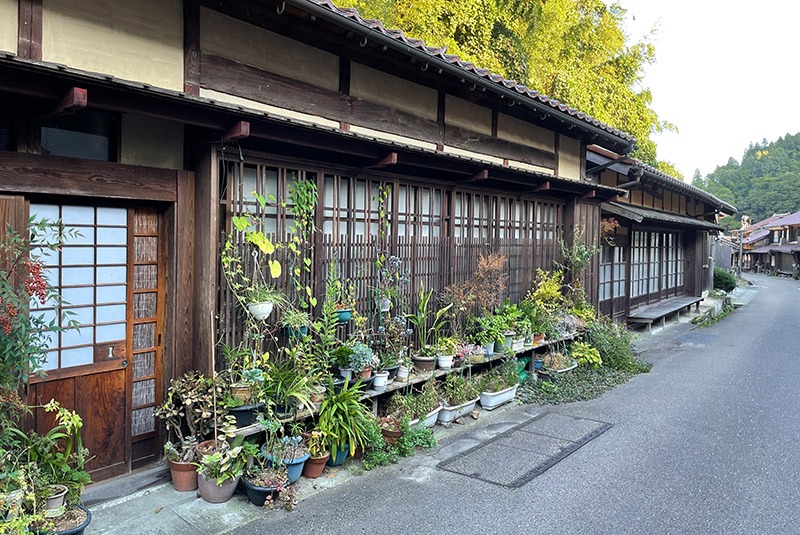
Our base was an 18th-century samurai residence that had been meticulously and elegantly restored by the wizardly Tomi Matsuba, and love was present in every detail, from the redolent tatami-matted rooms elegantly arranged with antique desks and exquisite hanging scrolls, to the flower arrangements that unobtrusively graced every room, to the shoji paper screens that had been carefully patched with colorful pages from textile publications, to the exquisite wooden table around which we ate in the massive kitchen that seemed sprung from the pages of a design magazine. Tomi-san’s dream was to bring the residence—and the village around it—back to life, and it was heartening to see her vision taking shape, as we met an exuberant team of young Japanese who have come to Omori to be part of her experiment.
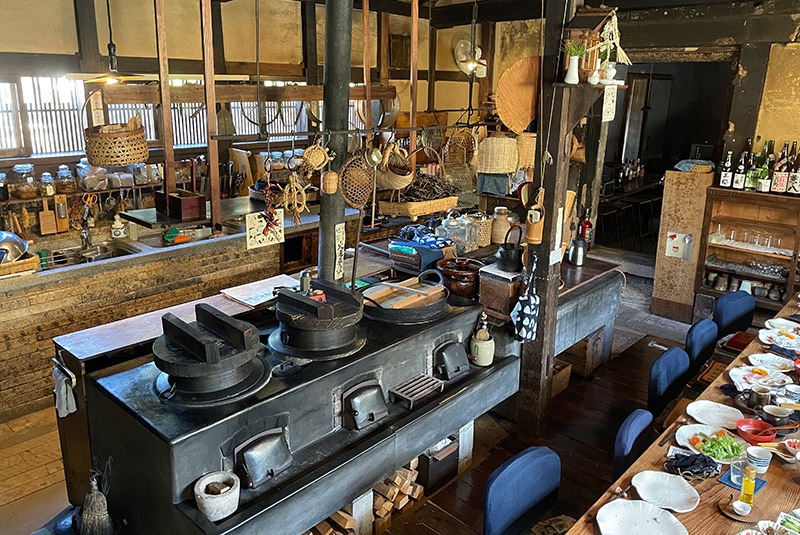
On our two-day stay we were privileged to spend considerable time with three of these young staffers: Tomoko-san, Chihiro-san, and Tak-san. Tomoko-san guided us to a twice-a-year pottery festival that was serendipitously taking place in a neighboring potters’ town the day after we arrived; there she spent her own precious private time introducing us to local potters and other friends. Chihiro-san organized all the details of our stay and showed us the intricate wonders of Tomi-san’s restoration work and the fundamental principle that work embodies: the importance of slowing down, paying attention, and honoring, appreciating, the possibilities and gifts, small and large, of the everyday world around us.
And Tak-san was the energetic and uber-talented chef who concocted two amazing 15-course feasts for our group using organic mushrooms, spinach, tomatoes, burdock root, lotus, persimmons, figs, and other produce from the fields of staffers and surrounding farmers, eggs from his friend’s own chickens, and fish from the port 20 minutes away. Tak’s version of traditional Japanese oden stew was scrumptious, and we all agreed that his rice powder-crust pizza would be a lines-around-the-block success in New York.
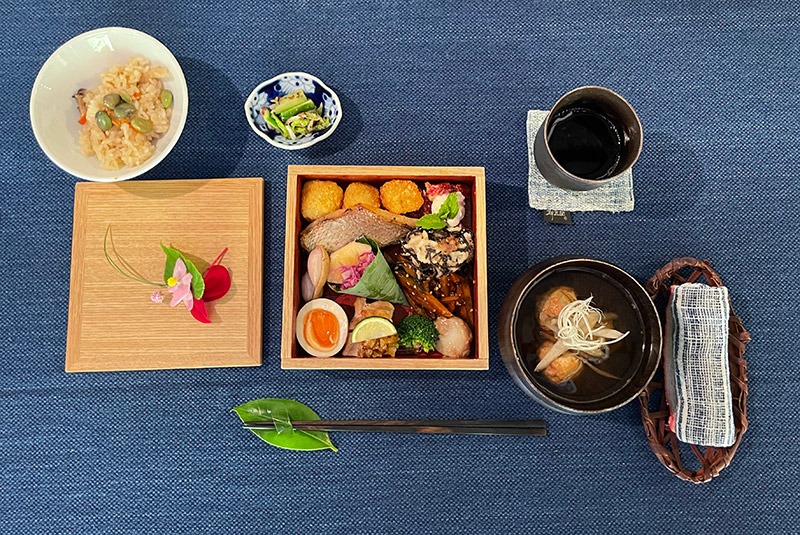
After our final night’s feast, some of the guests stayed at the table talking and asked Tomoko-san, Chihiro-san, and Tak-san if they could have a drink with us. They graciously assented and soon seven of us were sitting around the communal table, swapping travel stories and life-dreams, and toasting each other and the gifts that Tomi-san had bestowed.
Travel doesn’t get any better than this: There we were, sitting in the fantastical kitchen-dining room of a restored 18th-century architectural and design treasure, in a village of 400 people deep in rural Japan, sharing histories and hearts with three impassioned idealists who were devoted to the beauty and peace of Omori, and the principles of regeneration and self-fulfillment that threaded through Tomi-san’s dreams. Tomoko-san had been drawn from the chaos of Tokyo to the serenity of Omori; Chihiro-san had been raised in the region and had been inspired by Tomi-san’s vision to return to help in the revitalization of her homeland; and Tak-san had committed to raising his young family there. We talked and laughed and then drank a final toast to their inspiring achievements and dreams, and to the serendipitous journey that had brought us all together.
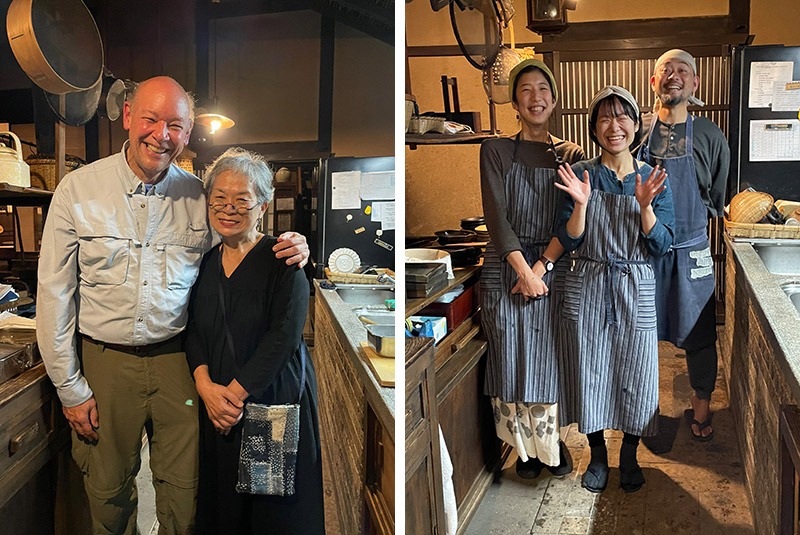
The following morning, none of us wanted to leave, and we parted with reluctant hugs, exuberant two-handed goodbye waves, and hearts filled to overflowing. As our bus pulled away, I looked back to see Chihiro-san jumping and jumping, waving, waving, waving, her sun-bright smile lighting our way.
Fishing and Feasting in Ine:
The third highlight was the fishing village of Ine, so far off the beaten path that it didn’t even show up on my Google map. There we stayed in fishermen’s houseboats, talked with a retired fisherman about the old days when he rose before dawn to go out in his boat and his life depended on the whims of weather and current, and learned from a passionate expat-become-local named Jun Ishikura, who organized our stay, about daily life in Ine and her own efforts to revitalize the village through conscientiously modulated tourism.
One unforgettable morning we rose at dawn to go to the local harbor. As the morning’s catch was brought in, the peaceful seaside scene was transformed into a maelstrom of activity. The biggest fish—including some almost as tall as us—were brought off the boat first, then huge plastic tubes were brought on to the boat and the remaining fish were sucked through the tubes onto conveyer belts. As they flowed down the conveyer belts, grizzled fishermen in blue waterproof overalls quickly sorted them, flinging them into blue crates. The crates were brought to another area where prospective purchasers hefted and assessed them, then tossed their selected fish, flipping and flopping, into big blue buckets or plastic coolers. When they were done, they lined up to have their fish weighed and to pay the price of the day for them.
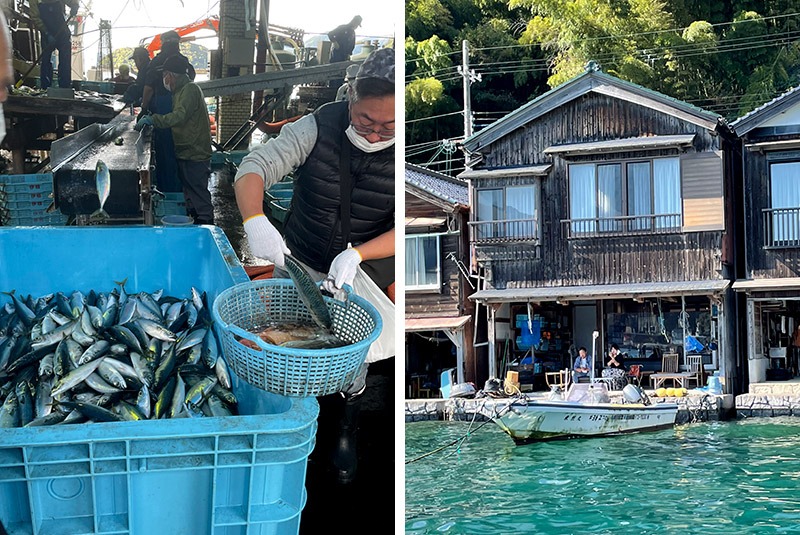
That morning adventure was fascinating, but for many of us, the climax of our visit was a dinner that was carefully and thoughtfully created and curated just for us by a sparkling young chef named Rie-san who had trained in Italy before winding up in Ine to work on a special international culinary project. That project had been scuttled by the coronavirus, but Rie-san had fallen in love with Ine and decided to stay, and we fell in love with her, and asked her to create an Italian-Japanese feast for us in the town’s tiny café.
Rie-san rose to the occasion with infectious energy and passion. It was deeply moving to watch her attending to the smallest details, carefully centering our mounds of al dente spaghetti on the colorfully bordered plates she had chosen specially for that dish, hand-picking sprigs of green and placing them just so on the succulently grilled fish, artfully adding a dollop of whipped cream to her delectable cheesecake.
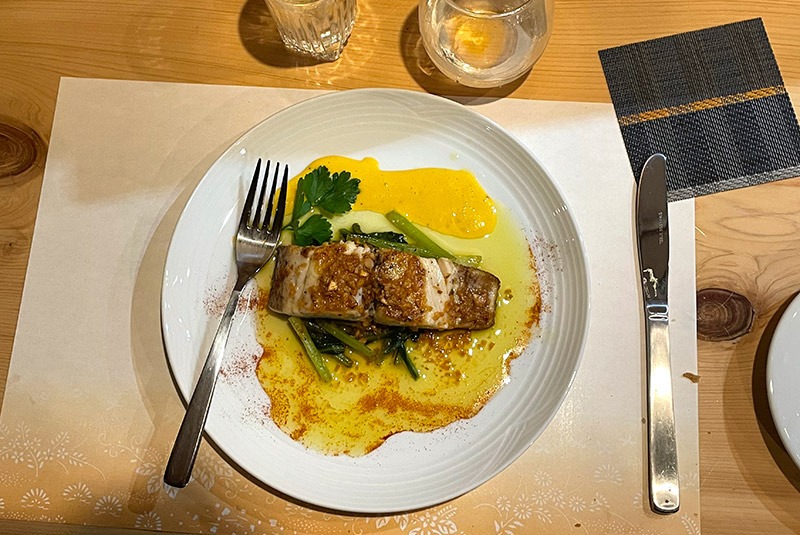
And it was profoundly gratifying to see her beaming in delight as silence settled over the room and we lost ourselves in enjoyment of each bite. As we oohed, aaahed, and oishii’d our way through the feast, we could almost see the arc of her career ascending from Ine to Japan’s culinary capitals and beyond. And when we burst into spontaneous applause at the end of the meal, we all felt part of that tasty trajectory.
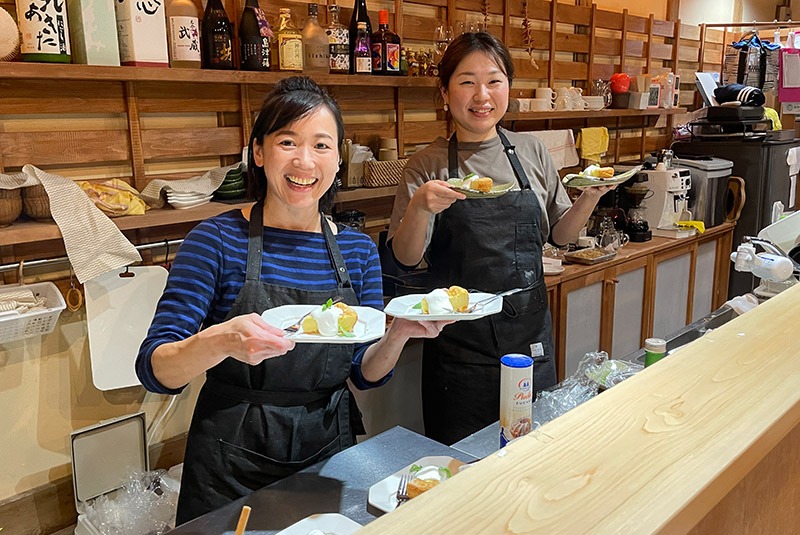
We ended the night with a toast to Rie-san and to the cafe’s entrepreneurial owner, Miyoko-san, and to the dreams and possibilities they both embodied. Little did we expect that one of the most fabulous meals of a trip that was distinguished by a dozen truly superlative feasts would be created in an off-the-map fishing village on the Japan Sea.
There were many, many more highlights from our journey: adventures in indigo-dyeing and salt-making; visiting the country’s atmospherically charged oldest Shinto shrine, Izumo Taisha; an impromptu reading in the former home of my hero Lafcadio Hearn, the 19th-century Irish-Greek writer who had introduced Japan to the Western world; a serendipitous once-a-year food and crafts festival in Omori itself; and a stunning stop at the spectacular Japanese Gardens at the Adachi Museum of Art.
Especially poignant were impromptu meetings with a spectrum of people, from farmers and fishermen to shopkeepers and chefs. One of these that especially moved me was a carpenter we met at Izumo Taisha. He showed us the pilgrimage book in which he had collected hand-calligraphed stamps from the shrines and temples he had visited on his pilgrimage, then explained that he was planning to leave the book at Izumo Taisha because he had completed the quest that had prompted his pilgrimage and now it was time to move into a new chapter in his life. “I think meeting you all today, sharing my story with you, is the perfect way to end and begin again,” he said, breaking into a huge smile. Like so many of our encounters, this serendipitous meeting—with a yearning, thoughtful soul on the cusp of a new beginning—reverberates within me still.
Thinking about this now, I realize that we encountered so many beginnings on this journey, and that the trip itself, this trailblazing exploration of a little-visited slice of Japan, was also a beginning for GeoEx—and the realization of our own long-held dream.
Reflecting on these wonderful immersions in rural Japan with two groups of intrepid, appreciative travelers, I think that we are always pilgrims on life’s path, and that if we are very lucky, we are occasionally blessed with adventures like these, where all the elements come together and we emerge enriched in unexpected ways and in some fundamental sense transformed.
I think of Otani-san, Masakazu-san, and Reiko-san; Tomi-san, Tak-san, Tomoko-san, and Chihiro-san; Jun-san, Rie-san, and Miyoko-san. I picture their exuberant, shining faces and irrepressible energy, and the equally beaming faces of my fellow travelers. I think of the hugs and tears that graced our final farewells, and I feel that, just like the places we visited, in some way we have all been regenerated and renewed. And I know that just as we will soon regale our friends at home with tales of the wonderful people we met in Japan, they are already regaling their families and neighbors with tales of their new friends from the West.
So the maps of our world have expanded, from part to part to part. So the bridges we have built will continue to grow, from heart to heart to heart.
* * * * *
What special experiences have you enjoyed on your travels? Have you met people who will remain in your heart long after the journey? Share your stories of meaningful connection in the comments section below. We love hearing from you! Thank you!
Don-san, it seems to me that, no matter where you go, a whimsical trail of toothy grins and heartful laughter always follows. If my desire to wander Japan off the beaten path wasn’t already ignited, it’s now aflame! It’s wonderful to read your stories, as always. Xx
Bri nailed it! You are the master! Palate-epiphany, karaoke, toothy grins, and all!
Thanks for sharing this adventure with us!! Amazing!!
I love the way you bring to life your deep engagement with wherever you are and with whom. Thank you. I look forward to sharing your trip in March with you in japan which I know will have many deep cultural experiences just because of who awe are and the light that we bring!
What a beautiful journey to share with you first thing this snow-covered Sunday morning. Thanks for this lovely surprise, a gift from your beloved Japan!
WOW. A foodie fest and a palate epiphany on top of encounters with some special people. Life doesn’t get much better. I’m so happy you’re doing what you love again.
Thank you for sharing this wonderful blog which captured the magic of traveling off the beaten track and the marvelous experiences Japan has to offer, especially the people and the food. Having traveled to Japan a number of times, this is a part of the country we have not explored. We feel fortunate to be joining this tour in 2023 and look forward to the experiences and the memories we will have..
Thank you Don Gerorg
Wonderful story, thank you so much for inviting me to read the article.
Wonderful story, Don! Thank you.

